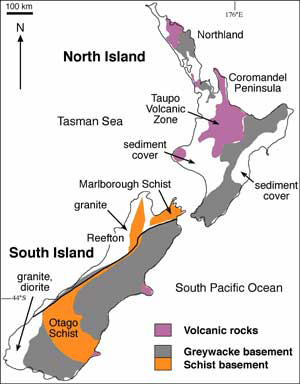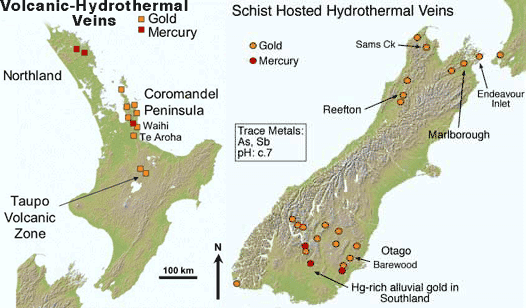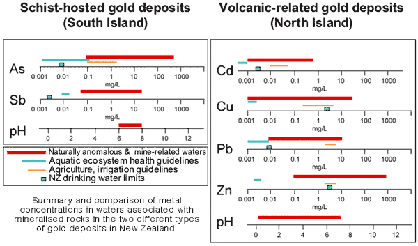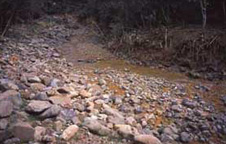
Click on a region to see corresponding deposits types in that region.
Geological background
Essential features
- Main rocks of New Zealand relevant to this topic are summarised in the map to the right. This map shows where the principal rocks are exposed at or near the surface.
- In detail, the basement (bedrock) is exposed on ridges and mountains. Intervening valleys, basins, and coastal plains are filled with sediments of varying ages. These topographically low areas are readily apparent on the maps in the maps below.
- Basement is greywacke (old ocean sediments) and schist (same sediments transformed with heat and pressure) beneath most of both islands.
- Greywacke and schist are chemically similar over large areas, so the basement is essentially uniform.
- South Island is dominated by greywacke and schist.
- Exceptions are granites and related rocks on the west coast of the South Island (not important for environmental metal mobility).
- Locally thick sediment covers some basement, especially in the North Island. Some of these sediments are coal-bearing, which has some environmental significance.
- Young volcanic rocks were erupted on to basement and sediments, and form some mountains.
- Volcanic rocks are most important in the North Island, especially Taupo Volcanic Zone, Coromandel Peninsula, and Northland.

Metals in the environment
- Principal naturally occurring metals that are environmentally significant in the New Zealand geological setting are listed in Table 1.
- Metals occur in distinctive associations that are related to the geological setting. These associations are listed in Table 2, in relation to geological settings described below. The different gold deposit types (see maps above) are most important in New Zealand.
Table 1
Environmentally significant metals which occur in elevated concentrations in some New Zealand rocks. ARD = acid rock drainage, mainly due to formation of sulphuric acid during oxidation of pyrite.
| Metal | Principal primary minerals | Geological setting | Environmental mobility |
| Aluminium, Al | Most rock-forming minerals | All settings | High at low pH (ARD) |
| Antimony, Sb | Stibnite, Sb2S3 | Schist-hydrothermal | High |
| Arsenic, As | Arsenopyrite, FeAsS; pyrite, FeS2 (trace As); other sulphide minerals |
Schist–hydrothermal; volcanic-hydrothermal; sulphurous coals; trace in most rocks |
High |
| Boron, B | ? | Coal | High |
| Cadmium, Cd | Sphalerite ZnS (trace Cd) | Volcanic–hydrothermal | High at low pH (ARD) |
| Chromium, Cr | Chromite, FeCr2O4; Fe-Mg minerals | Gabbro; ultramafic rocks; trace in most rocks | Moderate at low pH (ARD) |
| Copper, Cu |
Chalcopyrite, CuFeS2 | Other sulphide minerals Volcanic–hydrothermal; schist (rare) |
High at low pH (ARD) |
| Iron, Fe | Many rock-forming minerals | All settings | High at low pH (ARD) |
| Lead, Pb | Galena, PbS | Volcanic-hydrothermal | High at low pH (ARD) |
| Manganese, Mn | Many rock-forming minerals (with Fe) | All settings | High at low pH (ARD) |
| Mercury, Hg | Cinnabar, HgS; some pyrite (trace Hg) | Volcanic-hydrothermal | Moderate-low, volatile |
| Molybdenum, Mo | Molybdenite, MoS2 | Volcanic-hydrothermal | Low |
| Nickel, Ni | Many rock-forming minerals (with Fe, Mg) | All settings | Moderate at low pH, especially coal ARD |
| Tin, Sn | Cassiterite, SnO2 | Volcanic-hydrothermal | Low |
| Tungsten, W | Scheelite, CaWO4 | Schist-hydrothermal | Low |
| Uranium, U | Uraninite, UO2 | Rare, coaly sediments, Paparoa Range, Westland | High |
| Zinc, Zn | Sphalerite, ZnS | Volcanic-hydrothermal; trace in most rocks | High at low pH (ARD) |
Table 2
Common New Zealand mineral deposits and their typical environmentally significant metal associations. Not all minerals in each deposit type are present in a single deposit.
Deposit type |
Metallic minerals |
Metals discharged |
pH |
| Schist-hydrothermal(mesothermal) | Pyrite, FeS2 stibnite, Sb2S3 arsenopyrite, FeAsS gold, Au scheelite, CaWO4 cinnabar (rare), HgS |
As, Sb | 6-8 |
| Volcanic-hydrothermal (epithermal) |
a) gold-related pyrite, FeS2 sphalerite, ZnS galena, PbS arsenopyrite, FeAsS chalcopyrite, CuFeS2 |
As, Cd, Cu, Pb, Zn Fe, Mn, Al |
1-7 |
|
b) mercury-related pyrite, FeS2 marcasite, FeS2 (+ trace As, Hg) cinnabar, HgS stibnite, Sb2S3 |
Hg, As, Sb Fe, Mn, Al |
1-7 | |
| Coal | Pyrite (+ trace As) | As, Ni, Fe, Zn, Cu, B | 3-7 |
| Alluvial gold | Au Au-Hg amalgam pyrite and/or marcasite |
Hg, Ni, Fe, Zn, Cu | 3-8 |
Table 3:
Some water and rock metal contents in New Zealand historical mining areas, compared to ANZECC guidelines for agricultural water and aquatic ecosystems, and Ministry of Health drinking water limits. The upper ends of ranges for mine water and mine rock metal contents are for the mine type in column 4: "schist-hydro" = schist-hosted hydrothermal (mesothermal) deposits, and "volc-hydro" = volcanic-related hydrothermal (epithermal) deposits.
Metal |
Water (mg/L) |
Solids (mg/kg) |
|||||||||
Mine waters |
NZ drinking water limits |
Agriculture, irrigation guidelines |
Aquatic ecosystems |
Mine rocks |
Aquatic ecosystem sediment guidelines |
||||||
Lower |
Upper* |
*Mine type |
Lower |
Short-term |
99% protection |
80% protection |
Lower |
Upper* |
|||
Sb |
0.1 |
40 |
Schist-hydro |
0.003 |
? |
? |
0.009 |
? |
50 |
50000 (5%) |
2 |
Arsenic As |
0.1 |
500 |
Schist-hydro |
0.01 |
0.01 |
2 |
0.001 |
0.014 |
100 |
20000 (2%) |
20 |
Cadmium Cd |
0.001 |
0.8 |
Volc-hydro |
0.003 |
0.01 |
0.05 |
0.00006 |
0.0008 |
1 |
1000 (0.1%) |
1.5 |
Copper Cu |
0.001 |
20 |
Volc-hydro |
2 |
0.2 |
5 |
0.001 |
0.0025 |
1000 |
20000 (2%) |
65 |
Lead Pb |
0.001 |
10 |
Volc-hydro |
0.01 |
2 |
5 |
0.001 |
0.0094 |
1000 |
20000 (2%) |
50 |
0.0001 |
0.001 |
Volc-hydro |
0.002 |
0.002 |
0.002 |
0.00006 |
0.0054 |
1000 |
30000 (3%) |
0.15 |
|
Nickel Ni |
0.05 |
1 |
Coal |
0.02 |
0.2 |
2 |
0.008 |
0.017 |
10 |
100 |
21 |
Zinc Zn |
0.1 |
1000 |
Volc-hydro |
3 |
2 |
5 |
0.0024 |
0.0031 |
1000 |
30000 (3%) |
200 |
Metallic Mineral Deposits
Principal Metallic Mineral Deposit Areas
Gold deposits
Gold is the main metallic resource that has been mined in New Zealand for over 150 years. Deposits of other metals do occur, but nearly all these are geological curiosities only and have had no economic significance.
- New Zealand has had a favourable geological setting for gold deposit formation (a geological "accident").
- Gold is accompanied by other metals, which were discarded by early miners. Hence, much of the science of geological controls on metals in the New Zealand environment is tied to the geology of gold deposits.
- Two distinctly different gold deposit types occur (see maps above). Both of these are hydrothermal deposits, i.e., they were formed by hot water moving through cracks in the rocks before the rocks were deeply eroded.

Summary and comparison of metal concentrations in waters associated with mineralised rocks in two different types of gold deposits in New Zealand
Naturally elevated vs "polluted" or "contaminated" metal concentrations
 Coromandel stream draining epithermally affected rocks, with natural acidity (pH 3-4) and dissolved metals. Photo was taken after a major flood, when abundant new pyritic rocks had been exposed.
Coromandel stream draining epithermally affected rocks, with natural acidity (pH 3-4) and dissolved metals. Photo was taken after a major flood, when abundant new pyritic rocks had been exposed.
The significance of mining
- All of the settings and processes described in these pages are natural geological phenomena, and elevated levels of trace metals are normal; i.e., "background" is higher at some sites than others.
- Metal mobility can be enhanced or accelerated by mining activity, leading to localised metal contamination or pollution of streams
- The total amount of metals going down streams from mines is not necessarily increased, but mine excavations can focus the discharge into small areas at higher concentrations.
- Natural erosion can have similar effects to mining on metal mobility.
- Historic miners discharged mine tailings directly into streams, and these streams have now been largely naturally rehabilitated by floods.
- Mine tailings have been stored on mine sites since the 1960's, in response to environmental concerns.
- Elevated levels of trace metals from these tailings facilities should be expected as part of the naturally high background of many mining areas.
- Monitoring of tailings is essential to ensure that trace metal levels do not rise above natural levels, especially during periods of low rainfall when downstream dilution is lessened.
Related
Introduction
- Introduction to metals in the New Zealand Environment
Overview: Geological setting for Metals in the New Zealand environment
- Epithermal Gold
- Mesothermal Gold
- Acid Rock drainage
- Coal
- Metals in groundwater
- Alluvial Gold
- Northland Mercury
-
Hot Springs (in heavy metals)
